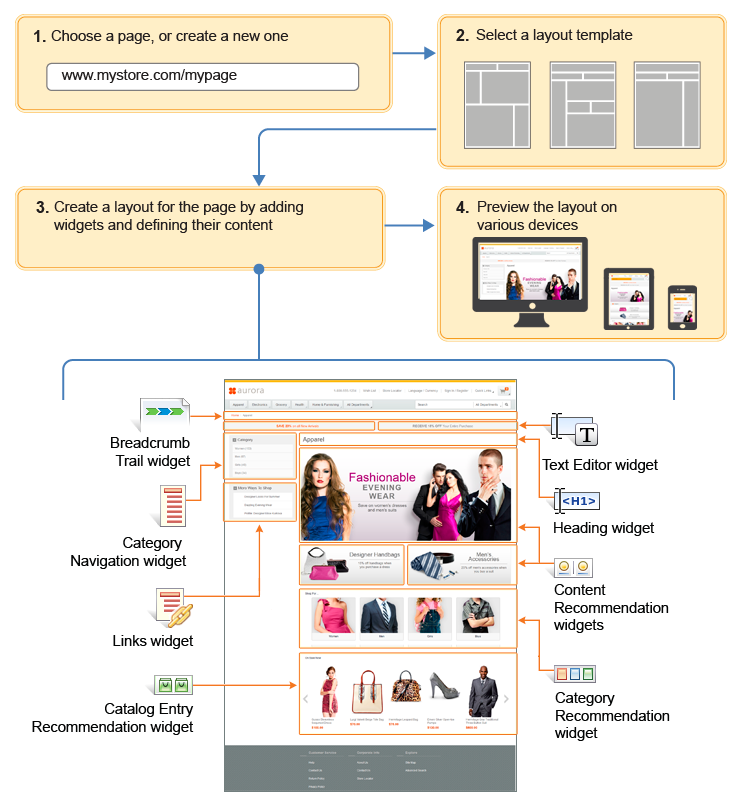Commerce Composer overview
From the Commerce Composer tool, you can compose a layout for a new or existing store page by following four basic steps:

How the Commerce Composer tool can benefit your business
The Commerce Composer tool puts the power to create and manage pages and layouts in the hands of business users. Tasks that were previously handled by store developers, such as creating new pages and arranging elements within a page, can now be completed directly in Management Center. By taking advantage of the Commerce Composer tool, as a business user, you can:- Launch new marketing campaigns quickly and efficiently because you have complete control over store page creation and assembly.
- Use a rich set of templates and widgets to design compelling pages that offer shoppers a personalized browsing experience.
- Enjoy a more streamlined approach to page content management by using fewer Management Center tools and screens.
- Continue to use the powerful precision marketing capabilities that are offered by the Marketing tool, such as web activities and marketing experiments. These capabilities are supported in a number of widgets in the Commerce Composer widget library.
- Apply layouts consistently across categories and other page types by using the same layout template or layout for multiple pages.
- Create layouts for specific devices (desktop or mobile), and responsive layouts that adapt to any device.
- Quickly enable third-party widgets to enhance your page designs.
The Commerce Composer tool supports the following key WebSphere Commerce capabilities:
- Workspaces: The pages and layouts that you create in the Commerce Composer tool can be managed in a workspace.
- Extended sites: Widgets are published at the site level, making them available to all stores in an extended site.
- In-context preview and click-to-edit: These two store preview functions help you move more efficiently between the Commerce Composer tool and store preview while you are working on pages and layouts.
In addition, IT developers can use the Data Load utility to load new pages, widgets, layout templates, and layouts directly to the database so that they are available in the Commerce Composer tool.
Initial setup for the Commerce Composer tool
When your company decides to adopt the Commerce Composer tool, you must decide which store pages to manage in the tool. For example:- Your company might decide to manage category pages, the home page, the search results page, and all general content pages in the Commerce Composer tool. Pages with layouts that change over time are good candidates for the Commerce Composer tool.
- For other pages, such as account and check-out pages, your company might continue to use existing page management methods. If so, these pages cannot be accessed in the Commerce Composer tool.
Your company must also decide whether any or all pages that are managed in the Commerce Composer tool will follow a responsive web design (RWD) pattern.
For the pages that you decide to manage in the Commerce Composer tool, web designers and IT developers must prepare suitable layout templates and widgets. To speed up this process, WebSphere Commerce provides a set of layout templates and a Commerce Composer widget library to use as a starting point. Both the templates and widgets follow a responsive web design pattern.
After IT developers load your custom layout templates and widgets to Management Center, you can begin creating and managing pages and layouts in the Commerce Composer tool. Over time, IT developers can load new layout templates and widgets, and remove templates that are no longer used.
Access control
The following Management Center roles have full access to manage business objects in the Commerce Composer tool:- Seller
- Marketing Manager
- Sales Manager
- Workspace Task Group Approver